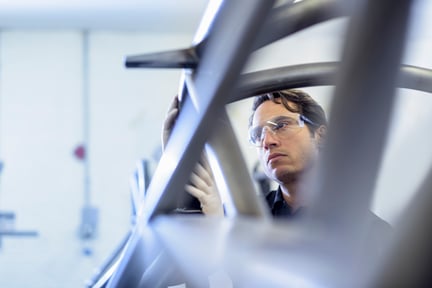Client challenge
Mainstay’s innovative approach to property management is demonstrated by its commitment to customer service, customer experience, communication and people empowerment values, taking ownership, caring and working in unity with its stakeholders.
Achieving ISO 9001:2015 certification contributes to Mainstay’s vision for transforming property management. By bringing risk management and excellence to the forefront of its organisational processes, it has improved performance and customer service at the same time.
Rebecca Usher, Business Improvement Manager at Mainstay, explains how they transitioned to the new standard and outlines some tips for organisations who are new to quality management and ISO 9001.
Client insight
Context of the organisation
Organisational context in ISO 9001 wants organisations to understand any internal and external threats and opportunities that may impact the business. Rebecca describes Mainstay’s approach:
“To fully understand our threats and opportunities, we execute the PESTLE and SWOT exercises. This information enables us to regularly analyse our internal and external issues, which helps us to identify any opportunities and threats that may impact on our business.
Regular management review meetings with the senior management team enable us to monitor and review any changes that may specifically impact on our organisation, positively or negatively. This helps us to understand if we need to address or add anything to our quality management system (QMS) processes.
Departmental heads devise objectives and KPIs which are directly linked to the company’s vision and cornerstones, thereby improving the organisation’s performance as a whole.
Management review meetings are also a great opportunity to ensure all requirements in ISO 9001 are discussed at length by members of the senior management team. Likewise, they are a great tool to enable us to document everything and gain senior management buy-in”.
Rebecca continues, “Although ISO 9001:2015 has a greater focus on understanding and meeting the needs of interested parties, Mainstay already worked hard to build a good rapport with its customers and other stakeholders, continuously striving to meet their needs.
We have always had a good relationship with our key contractors, where our Compliance Manager holds regular consultation meetings with our statutory compliance contractors.
By using our current governance framework, we work hard to forge close relationships with our customers and endeavour to meet their changing needs and exceed expectations”.
Leadership
In ISO 9001 leadership is central to an organisation’s QMS success, and is aligned with the overall business processes making it relevant across the entire company.
Mainstay’s leadership team has always understood the importance of its QMS and understands the significant contributions it makes to the business.
“If I need support, the Managing Director will deliver key messages and requirements to the business to ensure that things get done. Buy-in for the management system is reiterated at the Managing Director briefings and employee workshops. Employee engagement surveys are regularly sent to all staff. The feedback is taken seriously and contributes to the continual improvement of our QMS”, says Rebecca.
“We have a ‘Red-Letter’ system where employees can submit continual improvement ideas to the leadership team. All ideas are presented to the employees during regular town hall meetings and are not vetted prior to the meetings. The ideas are then discussed openly between the leadership team and staff.
Employee buy-in is fantastic as they really feel like their ideas for continual improvement are being heard and can see them being implemented into the company processes. It also highlights the leadership team’s engagement in taking ownership of our continual improvement processes”, Rebecca concludes.
Risk-based thinking
Every organisation faces uncertainty and how this is addressed can often influence and even determine an organisation’s success. Built on the principle of risk-based thinking,
ISO 9001:2015 provides a structured approach to the issues that are most likely to impact on your organisation.
Mainstay believes that gaining ISO 9001:2015 has enabled them to better identify, manage and mitigate risks and helped them to embed risk management into their organisational processes.
“Achieving ISO 9001 has given more opportunity for individuals at all levels within the organisation to identify risks and opportunities, which can be fed upwards rather than downwards. Objectives and KPIs are set to accompany this, helping to embed risk management at the heart of our processes.
Independent certification looks at our ability to manage our risks. By having external assessors come into our organisation they can identify areas that we may not have identified ourselves.
We have a risk register that is set at a high-level and we ask departments to consider what they think the risks are to their department and processes. We then make sure these risks are aligned with the risk register and the lower levels of the organisation, using a bottom-up approach”, states Rebecca.
Process approach
Sustained success does not occur by coincidence. It comes from meeting objectives through well-designed and executed processes. ISO 9001:2015 requires organisations to take a process approach, providing a 360-degree view of their operations.
"Implementing ISO 9001 has helped Mainstay gain a clearer understanding of the key inputs and outputs to processes and how these correlate with our identified objectives, KPIs and risks. It has given us a more transparent overview of what happens in between, providing us with information to help identify any issues or opportunities that may have previously been missed.
Every element of ISO 9001 improves performance and in terms of tendering for new business, it makes a difference for people wanting to work with us”, explains Rebecca.
In the long-run ISO 9001 can vastly improve efficiencies and help mitigate risk.
Business Benefits
Rachel Dobson, Head of Health & Safety and Fire Safety at Mainstay, outlines the benefits that they have seen after achieving ISO 9001:2015. Paying particular attention to streamlined processes, Rachel explains how ISO 9001 improved efficiencies, risk management and continual improvement, which helped to improve the business performance as a whole.
“Achieving a management system certification to any international standard enhances an organisation’s reputation, improves efficiencies and its risk management approach, particularly with the occupational health and safety (OH&S) management system standard.
ISO 9001’s continual improvement model identifies nonconformities and opportunities for improvement, helping us to focus our priorities. We are always trying to find ways to improve the systems we already have and it’s exciting when you have a breakthrough, which you know is going to make a big difference.
ISO 9001 can take a long time to implement and it needs business-wide ‘buy-in’, so cost and resource are valid concerns for many organisations. In the long run though and if implemented effectively, ISO 9001 can vastly improve efficiencies and help mitigate risk. It also enhances your reputation, helping to bring in new business with more people wanting to work with you, directly impacting the bottom line.
Being monitored against the standard by an external organisation such as LRQA, makes sure the business is doing what it’s supposed to be doing. For example, it ensures staff get the training they need and that this training is consistently evaluated and that staff appraisals are undertaken according to planned arrangements”, describes Rachel.
How we helped
At LRQA, we allocate assessors who have auditing experience for your chosen standard and industry sector. This enables us to add real value to your assessment visits by making the appropriate recommendations to improve your management system whilst improving your business.
We make sure that certification from LRQA provides credibility for your stakeholders through the globally recognised LRQA brand. In the UK, we hold accreditation from the United Kingdom Accreditation Service (UKAS), demonstrating we have the expertise to conduct assessments against ISO 9001 requirements.
Rebecca explains why these two points are so important for Mainstay: “It was important for us to choose a certification body that is externally accredited to reassure us that we are doing things correctly. LRQA was the first certification body to achieve accreditation from the United Kingdom Accreditation Service (UKAS) providing us with that all-important credibility, and because of their thorough approach, we have the reassurance that we are managing risks effectively.
We continue to use LRQA because we respect their technical expertise, professionalism and pragmatic approach. Our auditor enables us to gain insight from somebody who doesn’t work for the organisation and uses their experience from working with other organisations to help us implement robust corrective action measures. For instance, we had been investigating the implementation of a Legal Update Service and when it was brought up during one of our audits, it helped me gain top management buy-in to drive this forward”, concludes Rebecca.





